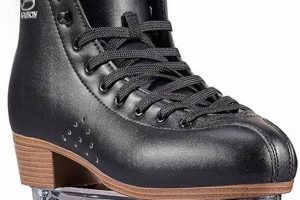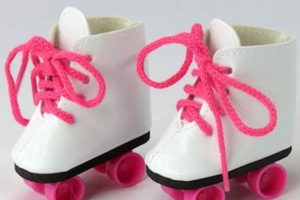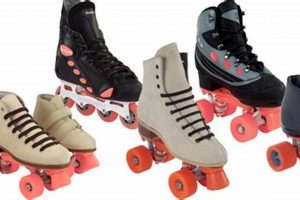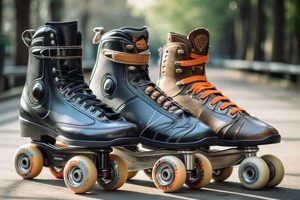These components, typically made of rubber, polyurethane, or similar materials, attach to the front of roller skate plates. These vital parts function as brakes, enabling skaters to slow down, stop, and perform certain maneuvers. For example, a skater might use these to execute a controlled stop or to gain leverage during a dance routine.
The presence of effective braking mechanisms significantly enhances safety for skaters of all skill levels. They allow for rapid deceleration in potentially hazardous situations, contributing to injury prevention. Historically, improvements in their design and material composition have paralleled advancements in roller skate technology and the increasing complexity of skating styles.
A deeper examination of these components encompasses factors like material selection, thread types, adjustability options, and their impact on overall skating performance. Subsequent sections will delve into these aspects to provide a more complete understanding.
Guidance on Utilizing Skating Brakes
The following recommendations will assist in optimizing the use and maintenance of skating brakes, ensuring safety and maximizing performance.
Tip 1: Material Selection: Consider the skating surface. Harder materials offer greater durability on smooth surfaces, while softer compounds provide enhanced grip on rougher terrains.
Tip 2: Regular Inspection: Examine frequently for wear and tear. Replace worn or damaged components promptly to maintain optimal stopping power and prevent accidents.
Tip 3: Proper Adjustment: Ensure they are adjusted to the appropriate height. A lower setting provides quicker engagement, while a higher setting allows for more clearance during maneuvers.
Tip 4: Thread Compatibility: Verify thread compatibility when replacing them. Incorrect threading can damage the skate plate and compromise the brake’s security.
Tip 5: Break-In Period: New components may require a brief break-in period. During this time, the material may slightly compress, requiring readjustment for optimal performance.
Tip 6: Cleaning and Maintenance: Periodically clean to remove dirt and debris. This prevents the buildup of contaminants that can reduce grip and responsiveness.
These guidelines emphasize the importance of regular inspection, appropriate adjustment, and informed material selection for these critical safety components. Adherence to these principles will contribute to a safer and more enjoyable skating experience.
The subsequent section will explore advanced techniques related to their use and customization.
1. Material Composition
Material composition is a primary determinant of performance and longevity in these components. The chosen material directly impacts grip, durability, and the overall skating experience. Understanding these material properties is crucial for selecting appropriate components.
- Polyurethane Compounds
Polyurethane offers a blend of abrasion resistance and grip. Various durometers (hardness levels) allow skaters to fine-tune the component’s feel. For example, a softer durometer provides enhanced grip on slick surfaces but may wear down more quickly than a harder compound.
- Natural Rubber
Historically, natural rubber was a common material. While offering good initial grip, it tends to degrade more rapidly than synthetics, especially under exposure to UV radiation or extreme temperatures. Its use is now less prevalent due to these limitations.
- Synthetic Blends
Manufacturers often employ proprietary synthetic blends to achieve specific performance characteristics. These blends may incorporate additives to enhance grip, increase rebound, or improve resistance to cracking and chunking. The specific composition is often a trade secret, but performance metrics provide insight into their capabilities.
- Reinforcements
The material composition can be reinforced through the use of fabric reinforcement, improving the strength of the component. This leads to improved grip on roller skate toe stops. Durability is also improved as the roller skate toe stops are reinforced with fabric.
The selection of an appropriate material requires careful consideration of the intended skating environment and the skater’s individual preferences. By understanding the strengths and weaknesses of different materials, skaters can optimize their equipment for safety and performance.
2. Thread Compatibility
Thread compatibility is a paramount concern in the maintenance and customization of these braking components. A mismatch in threading can lead to compromised safety and potential damage to the roller skate plate.
- Standardization of Thread Sizes
While variations exist, certain thread sizes are more prevalent within the roller skate industry. Metric (M8, M10) and imperial (5/16″, 5/8″) threads are common. However, deviation from these standards necessitates careful verification before attempting installation. Failure to match thread standards will prevent secure attachment.
- Consequences of Mismatched Threads
Forcing a mismatched component can strip the threads on either the part itself or the skate plate. This results in instability, reduced braking efficiency, and potentially hazardous conditions during skating. Repairing damaged threads often requires specialized tools and may necessitate replacement of the entire skate plate.
- Identifying Thread Types
Visual inspection is insufficient for accurate thread identification. Thread gauges or calipers provide precise measurements of thread pitch and diameter. Consulting the manufacturer’s specifications for both the skate plate and the replacement part is crucial for ensuring compatibility.
- Thread Locking Compounds
Even with compatible threads, applying a thread-locking compound (e.g., Loctite) can enhance security. This prevents loosening due to vibration during skating. However, selecting the appropriate compound strength is important; excessive strength can make future removal difficult or damage the threads.
The proper management of thread compatibility is essential for safe and effective use. Neglecting this detail can lead to equipment failure and potential injury. Prioritizing accurate identification and appropriate thread-locking techniques will ensure reliable performance.
3. Adjustability Range
The adjustability range of braking components directly influences a skater’s ability to customize their equipment for specific skating styles and personal preferences. This feature allows for fine-tuning engagement point and overall responsiveness.
- Height Adjustment and Braking Force
Altering the height of the component affects the leverage and force required for braking. A lower setting reduces the distance the skater must travel to engage the brake, resulting in quicker stops but potentially requiring more effort. A higher setting provides more clearance for maneuvers but increases the stopping distance.
- Impact on Skating Style
Aggressive skating styles, involving quick transitions and jumps, often benefit from lower settings. This provides immediate braking response. Conversely, recreational skaters may prefer a higher setting to minimize accidental engagement and maintain a smoother glide.
- Threaded vs. Threadless Systems
Threaded systems offer incremental adjustments, providing precise control over the height. Threadless systems utilize clamping mechanisms, allowing for faster adjustments over a wider range. The choice between these systems depends on the skater’s need for precision versus ease of adjustment.
- Influence on Plate Angle
The adjustability range can indirectly influence the skater’s plate angle. Lowering the component excessively might cause it to interfere with the skate plate during extreme leans or turns, restricting mobility. Conversely, setting it too high can affect weight distribution and stability.
The adjustability range provides skaters with a means to optimize their braking system. By understanding the relationship between height settings, skating style, and equipment design, skaters can achieve a balance of safety, performance, and personal comfort.
4. Surface Grip
Surface grip represents a critical performance attribute for braking components, directly influencing stopping distance, control, and skater safety. The friction coefficient between the component and the skating surface dictates the effectiveness of deceleration. Materials and design features are engineered to maximize this grip under varying conditions.
- Material Durometer and Friction
The durometer, or hardness, of the material correlates inversely with its coefficient of friction on most surfaces. Softer materials, characterized by lower durometer values, generally exhibit higher grip due to increased contact area and deformation around surface irregularities. However, excessive softness may compromise durability and lead to premature wear. Material science optimizes compounds to balance grip and longevity.
- Tread Patterns and Water Displacement
Similar to tire design, tread patterns on braking components can enhance grip, particularly on wet or uneven surfaces. Grooves and channels evacuate water and debris from the contact patch, maintaining a more direct interface between the material and the skating surface. The effectiveness of specific tread patterns depends on the surface texture and contaminant type.
- Surface Roughness and Adhesion
The microscopic roughness of both the component and the skating surface influences adhesion. A certain degree of roughness promotes mechanical interlocking between the two surfaces, increasing the resistance to sliding. However, excessive roughness can lead to increased wear and reduced efficiency. Controlled surface treatments are employed to optimize this characteristic.
- Environmental Factors and Grip Degradation
Environmental factors, such as temperature, humidity, and surface contamination, can significantly alter surface grip. Extreme temperatures may affect the material properties, either increasing or decreasing friction. Contaminants like dirt, oil, or water interfere with adhesion and reduce braking effectiveness. Regular maintenance and cleaning are essential for preserving optimal surface grip.
The intricacies of surface grip underscore the importance of material selection, design considerations, and environmental awareness in maintaining the safety and performance of roller skate braking systems. Optimizing these factors contributes to enhanced control and reduced risk during skating activities.
5. Durability Rating
The durability rating of these components is a critical indicator of their lifespan and resistance to wear under various skating conditions. It represents the component’s ability to withstand repeated stress, abrasion, and impact forces without compromising its primary function: providing controlled braking. The material composition, manufacturing processes, and design all contribute to a component’s overall durability rating. For instance, a braking component constructed from a high-durometer polyurethane compound will generally exhibit a higher durability rating than one made from softer rubber, directly impacting its longevity in aggressive skating environments. Similarly, reinforced designs featuring internal supports or external protective layers enhance a component’s ability to resist cracking or deformation under heavy use.
Understanding the durability rating is essential for skaters to make informed purchasing decisions. Skaters who frequently engage in demanding activities, such as roller derby or park skating, should prioritize components with high durability ratings to minimize the frequency of replacements. Conversely, recreational skaters who primarily use their skates on smooth surfaces may find that components with moderate durability ratings adequately meet their needs. Real-world examples illustrate the practical significance of this understanding: A roller derby player who consistently uses components with low durability ratings may experience premature wear, leading to reduced braking effectiveness and potential safety hazards during gameplay. In contrast, a recreational skater who invests in high-durability components may find that the increased cost is not justified by the relatively light use they receive.
The durability rating serves as a valuable metric for assessing the long-term value and performance of skating braking components. While a higher durability rating often translates to a higher initial cost, it can ultimately result in cost savings and improved safety over time, particularly for skaters who subject their equipment to significant stress. However, skaters must also consider other factors, such as surface grip and adjustability, to select components that best suit their individual needs and skating style. The ongoing challenge lies in developing components that strike an optimal balance between durability, performance, and affordability, ensuring that all skaters can access reliable and safe braking solutions.
Frequently Asked Questions About Roller Skate Braking Components
This section addresses common inquiries regarding roller skate braking mechanisms, providing concise and factual answers to enhance understanding and inform decision-making.
Question 1: What is the expected lifespan of roller skate toe stops?
Lifespan varies depending on material, skating style, and surface conditions. Frequent and aggressive use on abrasive surfaces accelerates wear. Visual inspection for wear indicators is crucial; replacement is indicated when significant material loss or deformation is observed.
Question 2: Are universal roller skate toe stops truly compatible with all skate plates?
The term “universal” is often a misnomer. While some components may fit a range of plates, thread compatibility is essential. Verify thread dimensions and consult the manufacturer’s specifications before installation. Mismatched threads can cause damage and compromise safety.
Question 3: How does temperature affect the performance of roller skate toe stops?
Extreme temperatures can alter material properties. Cold temperatures may stiffen the compound, reducing grip. High temperatures can soften the material, accelerating wear. Optimal performance is generally observed within moderate temperature ranges.
Question 4: What constitutes proper maintenance for roller skate toe stops?
Regular cleaning to remove dirt and debris is essential. Inspect for wear and tear, including cracks or excessive abrasion. Ensure secure attachment to the skate plate. Replacement should occur when performance is compromised.
Question 5: Do harder roller skate toe stops always last longer than softer ones?
While generally true, the relationship between hardness and lifespan is not absolute. Harder components may resist abrasion better but can offer reduced grip, potentially leading to longer stopping distances. The ideal hardness depends on the skating surface and desired performance characteristics.
Question 6: Can roller skate toe stops be customized for specific skating styles?
Yes. Material selection, adjustability, and tread patterns allow for customization. Aggressive skaters may prefer lower settings and high-grip materials, while recreational skaters may opt for higher settings and more durable compounds. Experimentation is encouraged to optimize performance.
Proper understanding of these key aspects, ensures informed selection and maintenance of skating braking equipment. Prioritizing safety through regular inspection and timely replacement remains paramount.
The subsequent section delves into advanced customization and fine-tuning techniques.
Conclusion
This discourse has extensively covered roller skate toe stops, examining their composition, functionality, maintenance, and customization. The critical role these components play in skater safety and performance has been underscored through an analysis of material science, adjustability factors, and adherence to safety standards. The multifaceted nature of these seemingly simple parts necessitates careful consideration for both novice and experienced skaters.
Ultimately, the selection and diligent upkeep of roller skate toe stops is not merely a matter of preference, but a responsibility. Continued research and development in material science and design will undoubtedly lead to further advancements in braking technology, enhancing safety and expanding the possibilities within the sport. Prioritizing informed decision-making and rigorous maintenance will ensure that skaters can pursue their passion with confidence and control.







